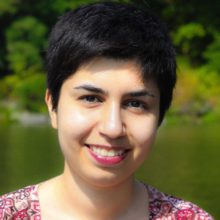PhD candidate, Columbia University
Email
Abstract
Breaking Lorentz Reciprocity Enables New Wireless Communication Paradigms: From Physics to Applications
The next generation of wireless communication networks is targeting orders of magnitude higher data rate than today’s systems. Various new emergent technologies are under investigation to enable the 5G revolution, such as massive MIMO and full-duplex wireless. Enabling these technologies require a re-evaluation and redesign of various layers of the communication system, from the PHY layer all the way up to the application layer. Taking the example of the PHY layer, the conventional reciprocal antenna interfaces of current wireless systems impose fundamental limitations on the radio front-end design and their applicability to these emergent technologies. To overcome these challenges, a fresh look into the physics of reciprocity and how to violate it is necessary.
Lorentz reciprocity is a fundamental characteristic of vast majority of electronic structures, but can be broken by violating one of its necessary conditions, namely time invariance, linearity or symmetric material tensors (permittivity and permeability). We have devised an approach to break Lorentz reciprocity by using linear periodic time-varying (LPTV) circuits and demonstrated the world’s first CMOS passive magnetic-free circulator based on staggered commutation (phase-shifting N-path filters), a form of spatio-temporal conductance modulation. Since conductivity in semiconductors can be modulated over a wide range (CMOS transistor ON/OFF conductance ratio can be as high as 1000 – 100000), our structure is able to break reciprocity within a compact form factor with very low loss and high linearity.
Furthermore, nonreciprocal antenna interfaces can potentially break some of the traditional receiver-antenna design constraints, and enable new front-end design methodologies. Based on our non-reciprocal antenna interface structure, I have designed novel full-duplex receiver architectures which merge the magnetic-free passive N-path filter-based circulator with the down-converter mixer and incorporate on-chip antenna balancing to enhance TX-RX isolation. These innovations lower the overall power and receiver NF while substantially enhancing the TX power-handling when compared with prior full-duplex receivers that integrate a shared-antenna interface on chip. Looking to the future, these integrated, high-performance reconfigurable radio front-ends based on non-reciprocal components are among the candidates for scalable 5G technologies such as massive-MIMO full-duplex.
Bio
Negar Reiskarimian received the Bachelor’s and Master’s degrees in electrical engineering from Sharif University of Technology in Iran, and is currently a PhD candidate in Electrical Engineering at Columbia University. Her research broadly focuses on integrated circuits and systems and applied electromagnetics, with a current emphasis on novel non-reciprocal components for emerging wireless communication paradigms. She has published in top-tier IEEE IC-related journals and conferences, as well as broader-interest high-impact journals in the Nature family. Her research has been widely covered in the press, and featured in IEEE Spectrum, Gizmodo and EE Times among others. She is the recipient of numerous awards and fellowships, including the Paul Baran Young Scholar, Qualcomm Innovation Fellowship, the IEEE Solid-State Circuits Society Predoctoral Achievement Award, the ISSCC Analog Devices Outstanding Student Designer Award and the IEEE Microwave Theory and Techniques Society Graduate Fellowship.
